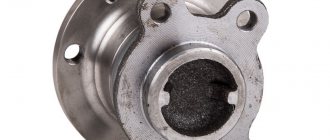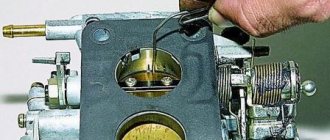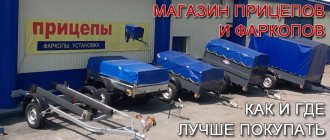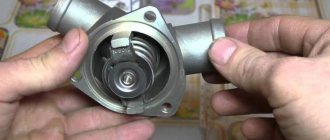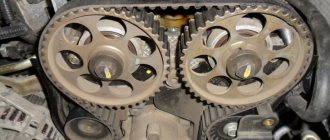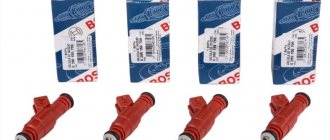The heating system in a car is designed as follows. The engine of the machine becomes hot during operation. To cool it, antifreeze is used, poured into the engine cooling jacket. This liquid heats up along with the engine, and when heated, it goes into the main radiator of the car. From there, through a system of pipes, hot antifreeze enters a small radiator of the stove, blown by a small fan. Heat from there enters the cabin through special air ducts and heats it. In the rear doors of the car there are exhaust openings necessary for ventilation of the interior. Excess heat escapes through them.
Diagram of the main elements of the heating system on the Daewoo Nexia
Here it should be noted one feature of the Daewoo Nexia heating system: it can operate independently of the air conditioner. Such design solutions on passenger cars are quite rare. The heater of the Daewoo Nexia not only heats the interior, but also prevents the glass from freezing, and it can work together with the air conditioner. This feature is useful if the driver wants to reduce the air temperature in the cabin by several degrees without turning off the heater.
Heater motor
The heater electric motor is installed behind the stove radiator. This compact motor rotates a plastic impeller, creating a continuous flow of air through the radiator tubes. The motor housing is metal, inside there is a rotor with copper winding and a central shaft on ball bearings.
The heater motor housing on the Nexia is made of tool steel
Metal-graphite brushes fit tightly to the rotor, removing the electrical charge. The engine catalog number is 6841SB566905. It is compatible with other Daewoo vehicles (for example, Daewoo Espero). Cost - from 5000 rubles.
Heater Vacuum Switch
The vacuum switch for the heater on the Daewoo Nexia is located behind the glove compartment. It is this device that is responsible for opening and closing the external air intake damper and the warm air recirculation dampers in the cabin.
The dampers on the Daewoo Nexia are opened using a vacuum switch
It is controlled using buttons located on the heater control unit. The device catalog number is ER200347893. The cost of a vacuum switch in Daewoo brand stores is from 600 rubles.
Video: repairing the Nexia vacuum switch
Heater fuse location
The Daewoo Nexia safety block is located under the dashboard, above the gas and clutch pedals.
The Nexia's stove fuse is located in the lower right corner of the block: it is green
It is closed with a plastic cover, on which there is a sticker with a diagram of the location of all fuses and relays.
The Nexia safety block is located above the pedals and is covered with a plastic cover
The fuse responsible for the heater is located in the lower right corner of the block and is designated as F19.
The fuse responsible for the Daewoo Nexia stove is marked F19
The same block contains a furnace fan relay, used in situations where the heater motor is running at low speeds.
Main malfunctions of the Daewoo Nexia heating system
There are many reasons why the stove may stop heating the interior of the car. Let's list the most common ones.
Oven radiator clogged
The heater radiator, like any other part, becomes unusable over time. This usually happens due to the use of low-quality antifreeze with an abundance of impurities. They form a layer of scale on the radiator tubes and its throughput begins to decrease. Eventually, fluid stops flowing into the radiator and the cabin becomes cold, despite the fact that the heater fan is operating normally. The problem is resolved by replacing the radiator.
A thick layer of scale and dirt is clearly visible in the Nexia’s radiator grille
Air lock in the heating system
Typically, a breakdown occurs when the tightness of a pipe in the heating system is lost. When air gets there, the circulation of antifreeze is disrupted, and it simply does not reach the stove radiator. The solution is to completely drain the antifreeze and then blow out the heating system with compressed air.
Due to ruptures in the air duct pipes in the Nexia heating radiator, air jams may occur
Vacuum switch failure
The vacuum switch on the Nexia is a reliable device, but the mounting strips on which it is held are quite thin and often break. This can lead to the fact that the air intake damper simply stops opening and the normal circulation of warm air in the cabin is disrupted. To fix the problem, the driver will have to purchase a new vacuum switch, since mounting strips for it are not sold separately.
Destruction of electric motor bearings
As mentioned above, the central shaft of the heating electric motor with the impeller is suspended on two ball bearings, which can collapse over time. If this happens, then after turning on the stove the driver will hear a characteristic creak, gradually turning into a loud grinding sound. The problem can only be solved by replacing the furnace electric motor, since the bearings for it are not sold separately.
Recycling
The heating system of Daewoo Nexia implies the presence of an air recirculation function. This is a mode that involves using air from the cabin rather than from the street. This is relevant in cases where the car is passing through an area of heavy smoke or gas pollution. It is important to close all windows, otherwise there will be no point in switching.
However, the driver and passengers may feel a headache if this mode is turned on for more than 15 minutes. This is due to the fact that oxygen does not enter the car, and the concentration of carbon dioxide exceeds the norm. Therefore, recirculation is used only in extreme cases, when there is, for example, heavy smoke outside and action has to be taken to prevent harmful chemical compounds from getting into the car. As soon as the car has passed the danger zone, the mode is turned off.
Experienced drivers are aware of the fact that at low temperatures outside, using recirculation will lead to rapid fogging and subsequent freezing of the windows. This process can lead to an emergency on the road, especially if the car is moving quickly. Therefore, in severe frosts, it is better to refuse to use the mode, even if it is necessary due to smoke.
Video: Daewoo Nexia climate control unit - what breaks there!
It is also worth noting that on cars higher in class than the Daewoo Nexia, recirculation is used automatically when washing the windshield. The washer fluid does not always have a pleasant smell, and its evaporation occurs in the immediate vicinity of the air intake. Therefore, a system has been implemented that includes air intake from the passenger compartment.
In conclusion, it is worth saying that the design of the stove is not something complicated. The climate control unit is easy to understand for drivers, even if they are new to driving the vehicle.
Heating control features
It is worth noting that the Daewoo Nexia stove operates independently of air conditioning, fully heating the car interior, as well as ventilating it if necessary, preventing freezing of the windshield and side windows due to their constant blowing of air heated by the heater radiator. In addition, the stove can also function when the air conditioner is on. For example, it is turned on to slightly reduce the temperature inside without turning off the heater. A design feature of the Nexia climate system is that the elements of the heater and air cooler form a single module, which is controlled using the heater controls located on the central panel.
Removing the stove control unit
The control unit for the heater in the cabin is a panel with levers and switches located on the center console. When dismantling the stove, you will need to remove it. This can be done in a few minutes by following these steps:
- Unscrew the fastening clips for the trim on the center console.
To remove the trim, you need to bend the fastening clips on the center console.
- Remove the lining.
After loosening the clamps, the cladding can be easily removed
- Disconnect the drive cable under the dash on the passenger side.
- Unscrew the fastening screw with a Phillips screwdriver.
- Remove the retaining ring.
- Remove the damper drive cable.
- Use a screwdriver to pry the heater control unit on each side and carefully pull the device towards you to release the latches.
After snapping the latches, the stove control unit is pulled out
- Remove the vacuum lines from the block.
- Pull out the heater tap cable and disconnect it.
- Disconnect the power terminal.
All lines and cables must be disconnected from the heater control unit
- Pull the control unit towards you further. After making sure that there are no connections left, remove the block.
Installing an additional pump on the stove
Another way to modify the stove would be to install an additional pump. The water pump ensures forced circulation of the coolant. The second pump will allow the antifreeze to circulate faster and heat the interior more intensely.
Installing an additional pump on the stove can take no more than half an hour, so it is quite possible to do this work yourself.
A standard pump is installed as an additional option
To install an additional pump you will need:
- the pump itself;
- metal clamps;
- a piece of hose 1 m long;
- set of screwdrivers and wrenches.
The work is performed in the following order:
- The small antifreeze circulation unit is assembled. To do this, the pump is connected to two pipes. A short piece of hose is connected to the antifreeze outlet fitting, and a longer piece is connected to the supply fitting.
- Coolant is drained from the system.
- The antifreeze drain hose is removed from the heater radiator.
- In place of the antifreeze discharge hose, the assembled unit with the pump is connected.
- The pump is securely fixed behind the facing panel, and the reliability of the hoses is checked.
- Antifreeze is poured into the expansion tank.
- The engine starts and warms up to operating temperature.
- Connections are checked for antifreeze leaks
Installing a second pump will increase the heating intensity of the interior
If the small fluid circulation circle operates without leaks, then the efficiency of the stove will increase significantly. It is recommended to install a second pump on used Daewoo Nexia cars, since due to partial wear of the mechanisms, the stove may no longer cope with its job.
Thus, it is quite simple to independently diagnose and repair the malfunction of the Daewoo Nexia car’s stove. Moreover, without resorting to the services of a car service, you can modify the heating system. In this case, the efficiency of heating the interior will increase noticeably.
Operating principles of the stove
Interior ventilation begins with the air intake, which is located under the windshield, inside the protective box. This design provides a constant flow of fresh air, regardless of the operation of the heater. The driver can turn on the heater, which will enhance the effect of ventilation or warming the car interior. To learn more about how the second option works, consider the Nexia climate system diagram.
The device of the Daewoo Nexia stove
The diagram of the Daewoo Nexia stove, which heats the interior, consists of the following elements:
- Heater radiator. The main element of the car interior heating system. The device changes the temperature of the air captured from the street, which warms up the car and blows across the windshield. The process occurs due to the interaction of heated antifreeze and the walls of the heater. Therefore, it is important that the coolant reaches 85-90 degrees.
- Fan. At high speeds, drivers prefer to turn off this element, since air enters the system on its own. If the car is stationary, then you have to use a supercharger, which consists of a motor and an impeller.
- Thermostat damper. An element that helps the driver control the amount of air directed directly through the heater core. If you reduce the gap, the cabin will become cooler and vice versa. Control is carried out from a common module.
- Executive element. The most important part in the heater module, which allows the vehicle owner to direct air flow in different directions. The principle of operation is to switch dampers that open or close the lines.
- Pipes, rods. With their help, the supply of heated coolant is ensured, which is necessary to create warm air in the climate system of the Daewoo Nexia.
If everything is clear with the elements of the heating system on the Daewoo Nexia, then all that remains is to understand the features of controlling this element of the car.
Let's sum it up
Considering that Daewoo Nexia is a budget car, some components are not of high quality and have a long service life. Unfortunately, the Daewoo Nexia stove can cause a lot of problems for the car owner, especially if it is actively used. A similar situation is observed with many VAZ models.
Finally, we note that timely replacement of antifreeze and the use of high-quality coolant can extend the service life of many parts of the cooling system and heater radiator.
If you additionally use flushing of the cooling system, then you can avoid blockages, slow down corrosion and significantly increase the performance of the heater.
Heater VAZ 2107: heater design, modification of the stove 2107, main malfunctions of the stove. Repair of the VAZ 2107 stove, tips and recommendations.
How to replace the radiator of a VAZ 2114 stove, subtleties and nuances. Replacing the heater tap of a VAZ 2114. Tips and recommendations on what to look for.
Signs of a faulty heater tap, major breakdowns and heater repairs. How to replace the VAZ 2114 stove faucet yourself. Choosing a stove faucet for replacement, tips.
Additional pump for a car heater: how it works and what it gives, how to choose an additional pump, installing an additional heater pump with your own hands. Recommendations.
The VAZ 2110 heater does not work: the main reasons why the VAZ 2110 stove does not heat well. Diagnostics, replacement of VAZ 2110 heater radiator, modification.
How to change the heater radiator on Kalina: the recommended method, as well as replacement without removing the dashboard. Choosing a replacement radiator for the Kalina stove.
Diagrams Daewoo Nexia N100-N150: equipment systems
The heater fuse is red daewoo nexia heating circuit is located in the mounting block in the instrument panel. To replace it you will need: To the left of the steering wheel, find the fuse box niche. Remove the cover from the block.
Diagrams of Daewoo Nexia NN Diagrams of equipment systems of Daewoo Nexia N and N 1. Diagram of the engine crankcase ventilation system, as well as details of the daewoo nexia heating diagram of the power unit suspension. Possible engine malfunctions, their causes and solutions: Features of controlling the Daewoo Nexia stove The heating system on the car in question functions separately, without connection to the air conditioner.
The stove warms and ventilates the interior, preventing fogging of the front and side windows. Sometimes drivers turn on the air conditioning while the heater is on. This allows you to quickly refresh the air inside the car and continue to warm the windows from fogging.
Therefore, the driver just needs to use the regulators located on the instrument panel to control the temperature inside the car. The Daewoo Nexia stove is controlled using the following elements that can be found on the instrument panel: Adjustment occurs in the direction of decreasing or increasing this indicator.
At the same time, the modes of the Daewoo Nexia stove are not affected by the position of the incoming air temperature regulator. The four fan speeds are changed using the difference in voltage supplied to the motor. A design feature of the Daewoo nexia climate system heating circuit is that the elements of the heater and air cooler form a single module, which is controlled using the heater controls located on the central panel.
Daewoo Nexia heater diagram. Purpose of the main components of the stove The design that heats the interior of the Daewoo Nexia is represented by the following elements.
How to determine the cause of the malfunction
Fuse location diagram
Without experience in servicing a technical device, it is extremely difficult to diagnose the source of the breakdown. For objective results, contact a workshop.
During an independent inspection, we recommend narrowing the search by grouping the breakdown “by characteristics.”
- Check the mechanisms for electrical components: the fan does not move when the switch is activated, the fan operates unstable, jerkily;
- Mechanical reason: the Daewoo Nexia stove blows cold air, insufficient airflow, weak air flow.
For repairs, we place the machine on a flat platform, or perhaps on an inspection hole for ease of diagnosis. We fix the rear row of wheels with wheel chocks, squeeze the parking brake, and move the rocker to the first gear position.
We start the engine, turn on the levers of the stove heating unit one by one. By this action we exclude (confirm) a breakdown in the electrical circuit. Let's assume it's a faulty fuse.
We recommend: How to set the ignition using a strobe?
We carry out the replacement ourselves, without going to a workshop. In accordance with the instruction manual, the fuse responsible for heating is located under the index “F12”. We remove it, insert a new one, the work is completed.
The fuse module is located behind the instrument panel, on the left side. Access from the driver's side.
Daewoo Nexia 2008, 80 l. With. - observation
The heater works, but does not direct air flow to the legs. Sometimes the heater starts to work strangely. It heats the air normally, but does not allow air flow to be directed to the lower part of the cabin.
In this case, you will have to remove the central panel of the machine and adjust the cable mechanism. First you need to make sure that there is no excess air in the system. To do this, you will need to open the hood and, with the engine warm, touch the antifreeze supply pipe connected to the radiator and the throttle hose with your hands.
Why does the stove heat poorly in the Daewoo Nexia? Causes of malfunction
If one of them is much colder than the other, then an air lock has formed in the radiator, which can be removed in 5 minutes. The refrigerant in the air conditioning system is under high pressure. When working with the refrigerant circulation system, avoid contact with the skin, eyes and respiratory tract.
Any work with refrigerant must be carried out only in a ventilated area. When refilling the air conditioning system, use only materials recommended by the manufacturer. It is prohibited to carry out welding or soldering work on the components of the air conditioning system.
Repair and maintenance work on the air conditioning system should be carried out by specialized services. Clogged stove radiator The heater radiator, like any other part, becomes unusable over time. This usually happens due to the use of low-quality antifreeze with an abundance of impurities. They form a layer of scale on the radiator tubes and its throughput begins to decrease.
Eventually, fluid stops flowing into the radiator and the cabin becomes cold, despite the fact that the heater fan is operating normally.
The problem is resolved by replacing the radiator. When air gets there, the circulation of antifreeze is disrupted, and it simply does not reach the stove radiator. The solution is to completely drain the antifreeze and then blow out the heating system with compressed air.
This can lead to the fact that the air intake damper simply stops opening and the normal circulation of warm air in the cabin is disrupted.
Now the stove body will be as sealed as possible, and there should be no blowing from the cracks. Incomplete closing of the cold air supply damper A common failure, due to which the stove does not heat well in a Daewoo Nexia car, is the operation of the damper.
It blocks air access to the radiator. The shutter stands in front of him. And in order for cold air to be supplied to the heat exchanger, the part must be raised.
It is controlled using a cable drive. If it works with play, the damper will open slightly under the influence of its own weight - cold air from outside will flow through the gap.
This gap will be small. But it is enough to significantly cool the air entering the cabin.
If there is no play, but the expected effect is also not observed, you will have to glue the edge of this damper using a D-shaped seal. To do this, you need to dismantle the lower radiator casing, having first removed the lower part of the console, and partially disconnect the radiator by moving it down a little. This may damage the thin-walled fin plates.
How to increase air flow in the stove
Sometimes car owners are faced with the fact that the heater in the Daewoo Nexia car does not blow into their feet. In this case, experienced car enthusiasts are advised to disassemble the control unit and find the rubber membrane. There will be damage on it, most likely a small hole. The result is that air is sucked in and cannot move the dampers. The hole needs to be sealed with any good rubber glue, let it dry, then assemble the block.
We recommend: How to replace the cabin filter of a UAZ Patriot with your own hands?
Important! To ensure simultaneous blowing of the feet and windows, it is necessary to block the damper or its drives in an intermediate position. In the second case, the movement of the drive is limited to two positions: suction or extrusion. The first provides air flow to the legs, the second - to the glass.
In a Nexia car, the stove blows weakly and when its channels are clogged or air bubbles begin to form in the heating system. The easiest way to get rid of them is to turn off the engine, open the expansion tank cap, then manually pour in antifreeze. Clogged channels are cleaned with cleaners for the cooling system and washed for seven to eight minutes.
Additional pump
If at first glance everything works properly, but in a Daewoo Nexia car the heater blows cold air, this means there is a manufacturing defect. There is no need to be upset; everything can be fixed by upgrading the stove.
Some motorists install an additional electric pump from a GAZelle on their car; Bosch pumps are also suitable. The pump is installed so that the antifreeze returns from the stove to the engine, then the flow of heating air into the cabin increases.
Heater radiator
The first sign of a malfunctioning heater core is a leak from the element itself. If the heating system shows signs of leaking, it must be replaced, otherwise there will be no warm air in the cabin. It is worth understanding that replacing the stove radiator, according to factory technology, is carried out after removing the dashboard. But car enthusiasts have come up with a way in which they do not need to dismantle the tidy.
So, let's look at how to dismantle the stove radiator using minimal means:
- We drain the coolant from the system so that it does not flow into the cabin.
- From the engine compartment side, disconnect the outlet and inlet pipes.
- We remove the glove compartment.
- We rest against the heater radiator, which can only be removed from its seat.
If the procedure seems quite complicated, then you will have to dismantle the instrument panel and remove the radiator according to the factory diagram.
Preparing for replacement and selecting tools
On Nexia N100 and N150, the heater radiators are different in volume and thickness, but interchangeable if desired. The dimensions are:
- N100 - 182x141x51 ;
- N150 - 180x138.5x26.
Radiators differ in thickness and method of fastening, but each can be installed instead of the other.
The replacement technology is identical on both versions, so we won’t focus on this. To operate, you don’t need a particularly complex tool - a set of screwdrivers and a 7-mm socket, preferably with a ratchet, extension and cardan.
First of all, we will decide on the location of the work; it will be more convenient if there is access to the machine from below. This is either a lift or an inspection hole. First, remove the protection from the engine and drain the antifreeze into a clean container. We disconnect the negative terminal of the battery, since we will have to disconnect the electrical connectors, and get to work.
Adjusting the heater dampers
Sometimes the damper cannot completely shut off the cold air supply. The flow of cold and hot air mixes, and the temperature in the cabin decreases. Adjusting the dampers is quite simple. To do this you need:
- Remove the heater control unit.
- Get to the radiator.
The stove radiator is the main source of heat - Using a socket or a size 7 ratchet, unscrew the three bolts at the edges of the radiator.
To remove the heater radiator, use a 7mm ratchet - Without disconnecting the wires and pipes, lower the radiator slightly, providing access to the dampers.
- Turn the damper with your hands first in one direction (cold air), then in the other (hot air) and find the gap between these positions.
- Fill the gap with caulk or rubber door seal.
- Adjust (tighten) the damper drive cable.
If a gap forms, the heater damper cable needs to be tightened
